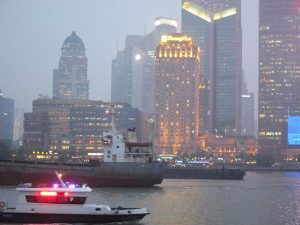 Shanghai, on the densely populated east coast of China, is the largest port in the world. Seven of the ten largest international ports are located on this Chinese east coast. Some 24 million people live officially in Shanghai, and another 6 million unofficially. In the eighth century it was a small fishing village on the Huangpu River. At the end of the thirteenth century it became a walled trading town.
Shanghai, on the densely populated east coast of China, is the largest port in the world. Seven of the ten largest international ports are located on this Chinese east coast. Some 24 million people live officially in Shanghai, and another 6 million unofficially. In the eighth century it was a small fishing village on the Huangpu River. At the end of the thirteenth century it became a walled trading town.
China has had coastal shipping for 4,000 years, rock drawings show. Around the beginning of our era, products already came from South-East Asia, the Roman Empire, the Arab world and from Africa. In the fifteenth century, the Chinese admiral Zheng He (1371-1433) made seven great voyages of discovery, with giant sailing ships, to thirty countries in South-East Asia, India, the Middle East and along the African coast. In the countries he visited, Chinese porcelain and copper objects from that time are still preserved. After that, China withdrew from world trade.
European countries tried to gain a foothold in China, such as the Netherlands with its United East India Company (VOC) and England with its East Indian Company (EIC). They bought tea, porcelain and silk, and wanted to sell European items, but the Chinese were not interested in that, they had everything they needed and found the European products inferior. Europeans paid with silver money that came from the mines in South America.
In the eighteenth century, Shanghai was the largest port in East Asia. With the invention of the steam engine, which started the Industrial Revolution, European countries became more powerful; they founded colonies and wanted to open up the Chinese market. They did this by shipping large quantities of opium grown in India to China. Two million Chinese became addicted to opium. In 1760, the Chinese ports were closed to foreign ships, except Guangzhou, formerly called Canton. When the opium trade continued clandestinely, China burned 20,000 boxes of opium. The British declared war on China, this was the First Opium War.
After that, a Second Opium War would follow. The Western European countries and the United States brought China to its knees, China had to open its ports, including Shanghai, to foreign trade. Shanghai was invaded by foreign entrepreneurs; the city had separate neighborhoods for the English, French and Americans, who had their own legislation and social life. Western bank buildings and large Western companies were built on the Bund, the boulevard along the Huangpu River.
The Communist Party was founded in Shanghai in 1921. In attendance was Mao tse Tung, who started a revolution, with millions of casualties in the end, to restore weakened and fragmented China to a strong state.
The People’s Republic of China was proclaimed in 1949. After Mao’s death, Deng Xiaopeng became leader; he introduced a kind of mixture of capitalism and communism: state capitalism. The country remained politically and socially authoritarian. The economy flourished, the middle class grew much larger, Chinese exports grew impressively. Shanghai became a free economic zone. In 2005, a new deep-sea port, Yangshan, about 30 kilometers off the coast of Shanghai, was completed; laid out on a few rocky islands. The port is connected to the city by a long bridge.




